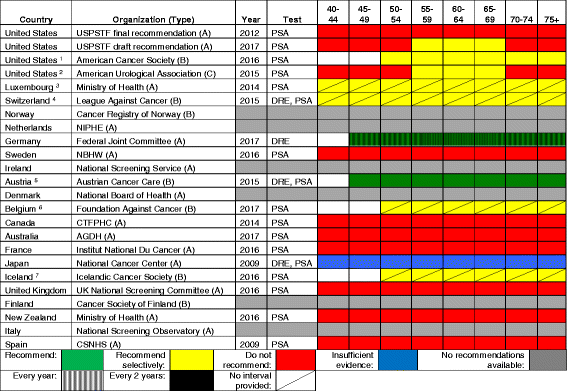
- Interval coding: vertical cross-hatch every year, solid every 2 years, diagonal line no interval provided
- Type of organization: A national guideline committee, B cancer society, C specialty society
- 1US American Cancer Society: screening should be done every year if PSA levels are greater than 2.5 ng/mL; stop screening in asymptomatic men with less than 10 years life expectancy; men at increased risk should consider beginning screening at 40 or 45 years
- 2US American Urological Association: an interval of 2 years or more is preferred. Additionally, baseline PSA levels can be used to individualize rescreening intervals. Screening should be stopped in asymptomatic men whose life expectancy is less than 10 years
- 3Luxembourg: age to start screening not provided. No organized national guidelines; screening based on individual discussion between patient and physician
- 4Switzerland: age to start screening not provided. No organized national guidelines; screening based on individual discussion between patient and physician
- 5Austria: “Screening should be carried out ‘regularly’ from the 45th birthday”
- 6Belgium: no organized national guidelines; screening based on individual discussion between patient and physician
- 7Iceland: no organized national guidelines; screening based on individual discussion between patient and physician
- Abbreviations: USPSTF United States Preventive Services Task Force, PSA prostate-specific antigen, NIPHE National Institute for Public Health and the Environment, DRE digital rectal examination, NBHW National Board of Health and Welfare, CTFPHC Canadian Task Force on Preventive Health Care, AGDH Australian Government Department of Health, CSNHS Cancer Strategy of the National Health System
